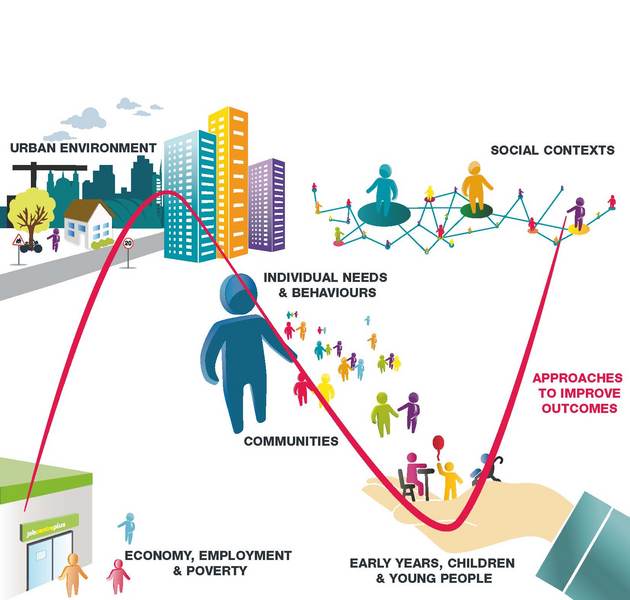
The ‘social stuff’: connections, communities and health
Our latest GCPH synthesis, published in February, discusses the inter-relationship between social contexts and health. It presents clear evidence about the importance of having:
- social networks of friends and families (as well as links to wider networks of support)
- a sense of belonging and safety in our neighbourhoods
- social activities to join in as participants or volunteers
- opportunities to have a say about decisions affecting our lives and localities.
Sometimes these aspects of people’s lives are discussed in terms of ‘social capital’, however, sometimes the language and theory underpinning social capital is off-putting or sometimes there is concern that blame is being assigned to people and communities deemed to be lacking in this ‘capital’. Although the terminology used to describe such relationships and connections between people can be difficult, what is clear from this synthesis of GCPH and GoWell evidence, is that the social aspects of our lives – the ‘social stuff’ – matters for our health and wellbeing.
Influence of income and place
It is also clear that these social aspects of our lives are very much intertwined with our levels of income and the quality of the places we live in. Hence, it’s not possible to separate out material and non-material influences on health, as they are clearly inter-related. If we look back at the period of deindustrialisation in Scotland, we see that the loss of workplace networks and experiences of poverty had a negative impact on the social fabric of communities. This was compounded by a policy emphasis on economic growth and physical regeneration, with a lack of attention to the impact on the social connections within communities and residents’ sense of belonging.
A focus on tackling poverty and income inequalities remains key to improving health and reducing health inequalities, but it is also important to recognise the interconnections with the social aspects of people’s lives. To be able to afford leisure and social activities and to have a home where it’s possible to invite friends round to visit means you can develop and maintain social networks. The quality, design and maintenance of our neighbourhoods impact on our levels of social contact and sense of belonging. Supporting and enabling residents in more disadvantaged communities to have a say in what happens in their communities and an opportunity to participate in decision-making processes is critical to addressing structural causes of inequalities and improving health.
Role of policy and practice
Our 2014 synthesis of 10 years of GCPH evidence reinforced the need to improve health and tackle inequalities with integrated actions across the areas outlined in the diagram below, namely: the economy, employment and poverty; early years and childhood experiences; neighbourhood environments; and social contexts. The 10 year synthesis also discussed that the way services and interventions (represented by the red line) are delivered impacts on outcomes for people and communities, and interact with these other areas outlined in the diagram. Of all the areas outlined, social contexts, is the one where it is often assumed that policy and practice will have least influence or where actions may have the least impact. This synthesis of GCPH and GoWell evidence on social contexts, however, demonstrates that policies and practices play a critical role in either enhancing or undermining the social features that support health: individuals’ networks of support; connections within communities; and opportunities to seek or influence change.
Of all the areas outlined, social contexts, is the one where it is often assumed that policy and practice will have least influence or where actions may have the least impact. This synthesis of GCPH and GoWell evidence on social contexts, however, demonstrates that policies and practices play a critical role in either enhancing or undermining the social features that support health: individuals’ networks of support; connections within communities; and opportunities to seek or influence change.
Alongside the fundamental need to tackle poverty and income inequalities, we need to ensure that policies and our public services consistently work with an understanding of how these social features support health improvement and the reduction of health inequalities. A lot of good work is already being done across Scotland to support people’s relationships and connections and to empower them to be involved in decisions that affect them, but there’s a need to take a harder look at how we further integrate the ‘social stuff’ into the way we conceive, develop and deliver policy and public services, for example:
- How do our public services identify and respond to individuals with weak family and friend networks to prevent individuals experiencing further difficulties and social isolation?
- How do our schools support young people’s social networks and participation in social activities despite differences in income?
- How are housing and planning decisions impacting on people’s networks and how are residents enabled to use spaces and facilities in their neighbourhoods?
- What work is undertaken in communities to support the integration of migrants and is sufficient support given to migrants, for example to enable them to acquire language skills?
- How do we enable people in more disadvantaged communities to take advantage of policies such as the Community Empowerment Act and Place Standard to narrow, rather than widen, inequalities?
Reflecting on the importance of social contexts for health also prompts wider questions about what we value in our society and how we promote greater co-operation between citizens and communities across cities and regions. This is critical, since we know that this will have a bearing on responses to future change and on Scotland’s future health status.
A synthesis of the evidence and discussion of the implications are detailed in the full report, and summarised in an accompanying leaflet.